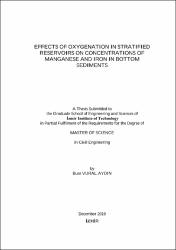Please use this identifier to cite or link to this item:
https://hdl.handle.net/11147/9649| Title: | Effects of oxygenation in stratified reservoirs on concetrations of manganese and iron in bottom sediments | Other Titles: | Tabakalaşmış rezervuarlarda oksijenleştirmenin dip sedimandaki mangan ve demir konsantrasyonlarına etkisi | Authors: | Vural Aydın, Buse | Advisors: | Elçi, Şebnem Ökten, Hatice Eser |
Keywords: | Drinking water reservoirs Iron Manganese Human health Hypolimnetic oxygenation Water quality |
Publisher: | Izmir Institute of Technology | Source: | Vural Aydın, B. (2019). Effects of oxygenation in stratified reservoirs on concetrations of manganese and iron in bottom sediments. Unpublished master's thesis, İzmir Institute of Technology, İzmir, Turkey | Abstract: | Iron and manganese accumulation in drinking water reservoirs is a challenging issue and should be controlled in order to prevent their adverse effects on human health. Accumulation of these elements not only clogs pipeline systems but also causes stains on fixtures and laundry. In addition, high concentrations of iron and manganese may lead to various health problems when ingested. This study focuses on the release mechanism of iron and manganese from sediments to water column and investigates methods to prevent this release. Effects of lack of hypolimnetic aeration, acid-base condition and thermal stratification on iron and manganese concentrations at water column were investigated through laboratory experiments. Experiments showed that total iron (Fe) and ferrous iron (Fe2+) concentrations in the water column decreased gradually following aeration in hypoxia conditions. A similar behavior was also observed for manganese concentrations. However, the concentration of dissolved manganese (Mn) in alkaline water condition is observed to be less than the aerated water case. This is an indication that iron and manganese react differently under different acidity of water in consideration. İçme suyu rezervuarlarında demir ve mangan birikimi önemli bir konudur ve insan sağlığı üzerindeki olumsuz etkilerini önlemek için kontrol edilmelidir. Bu elementlerin birikmesi sadece boru hattı sistemlerini tıkamakla kalmaz, aynı zamanda armatürlerde ve çamaşırlarda lekelere neden olur. Ayrıca, ağız yoluyla vücuda alındığında sağlık sorunlarına neden olabilir. Bu çalışma, sedimanlardan su kolonuna demir ve manganın salım mekanizmasına odaklanmakta ve bu salımın önlenmesi için yöntemleri incelemektedir. Deneylerde hipolimnetik havalandırma, asit-baz durumu ve termal tabakalaşmanın demir ve mangan konsantrasyonları üzerine etkileri incelenmiştir. Deneyler, su sütunundaki toplam demir (Fe) ve ferröz demir (Fe2+) konsantrasyonlarının, oksijensiz ortamın oluştuğu hipoksi su kolonunda havalandırma uygulaması ile birlikte zaman içerisinde azaldığını göstermiştir. Benzer bir davranış mangan konsantrasyonları için de geçerli olmaktadır. Fakat alkali koşullarda, suda çözünmüş mangan konsantrasyonu havalandırma koşuluna göre daha az olmaktadır. Bu da demir ve mangan elementlerinin su kolonunun farklı asidite koşullarında farklı reaksiyon verdiklerinin göstergesidir. |
Description: | Thesis (Master)--Izmir Institute of Technology, Civil Engineering, Izmir, 2019 Includes bibliographical references (leaves: 65) Text in English; Abstract: Turkish and English |
URI: | https://hdl.handle.net/11147/9649 |
| Appears in Collections: | Master Degree / Yüksek Lisans Tezleri |
Files in This Item:
| File | Description | Size | Format | |
|---|---|---|---|---|
| 10307150.pdf.pdf | MasterThesis | 2.6 MB | Adobe PDF |  View/Open |
CORE Recommender
Page view(s)
254
checked on Nov 18, 2024
Download(s)
196
checked on Nov 18, 2024
Google ScholarTM
Check
Items in GCRIS Repository are protected by copyright, with all rights reserved, unless otherwise indicated.